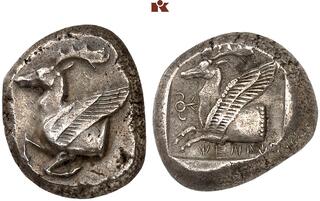| Fritz Rudolf Künker GmbH & Co. KG > Auction 402 | Auction date: 14 March 2024 |
| Lot number: 95 Price realized: 4,800 EUR (Approx. 5,226 USD) Note: Prices do not include buyer's fees. | Show similar lots on CoinArchives Find similar lots in upcoming auctions on |
| Lot description: LYCIA. Dynastische Prägungen. Khinakha AR-Stater, 470/440 v. Chr., Kandyba; 8,53 g. Geflügelte Hirschprotome l.//In Incusum: Geflügelte Hirschprotome l., davor lineares Symbol. Müseler IV, 67 (dies Exemplar); Müseler in Gephyra 15 (2018), S. 21, I/1, S. 27, Fig. 36 (dies Exemplar). Von allergrößter Seltenheit. Wohl Unikum. Sehr schön Exemplar der Auktion The New York Sale XIV, New York 2007, Nr. 123. 2016 bezeichnete Wilhelm Müseler die Münzstätte noch als unbestimmt. 2018 gelang es Wilhelm Müseler jedoch, die Münzstätte als Kandyba (das heutige Çataloluk) zu identifizieren. Das Symbol l. im Feld des Reverses ist ein persönliches Symbol des Khinakha. Kandyba, lykisch Xâkbi oder Xâzbi war ein Dynastensitz oberhalb der mittellykischen Kasaba-Ebene auf 740 m Höhe. Von dem Dynastensitz, der auf einem Felsrücken lag, sind noch die Fundamente erhalten (Hellenkemper – Hild 2004, 596). Die Stadt war stärker nach Mittellykien als nach Westlykien hin orientiert. Vom Xanthostal war sie durch hohe Berge abgetrennt. Um Kandyba gab es größere Wälder, die von Plinius in seiner Naturgeschichte (V 101) erwähnt werden. Insofern kann der geflügelte Hirsch auf der Dynastenprägung nicht wundern (vgl. dazu auch Vismara 1996, 153 f., die die Einzigartigkeit des Motivs, nicht aber seinen Hintergrund gesehen hat). Nach der Hellenisierung Kandybas kam der Mythos auf, der griechische Flutheros Deukalion sei mit seiner Arche auf dem Burgberg von Kandyba gelandet und sein Sohn Kandybos habe die Stadt gegründet (Chuvin 1991, 136). [JN] In 2016, Wilhelm Müseler assigned this piece to an unknown mint. In 2018, however, Wilhelm Müseler was able to identify the mint as Kandyba (today's Çataloluk). The symbol l. in the field on the reverse is a personal symbol of Khinakha. Kandyba, Xâkbi or Xâzbi in Lycian, was a dynastic seat above the Central Lycian Kasaba plain at an altitude of 740 meters. The foundations of this dynastic seat, which lies on a rocky ridge, are still preserved (Hellenkemper – Hild 2004, 596). The city was rather orientated towards Middle Lycia than towards Western Lycia. High mountains separated it from the Xanthostal. There were large forests around Kandyba, which are mentioned by Pliny in his Natural History (V 101). In this respect, the winged stag on dynastic coins is not surprising (cf. also Vismara 1996, 153 f., who recognized the uniqueness of the motif, but not its background). After the Hellenization of Kandyba, a myth arose according to which the Greek flood hero Deukalion had landed with his ark on the castle hill of Kandyba, where his son Kandybos founded the city and named after himself (Chuvin 1991, 136). [JN] Estimate: 2500 EUR |  |



